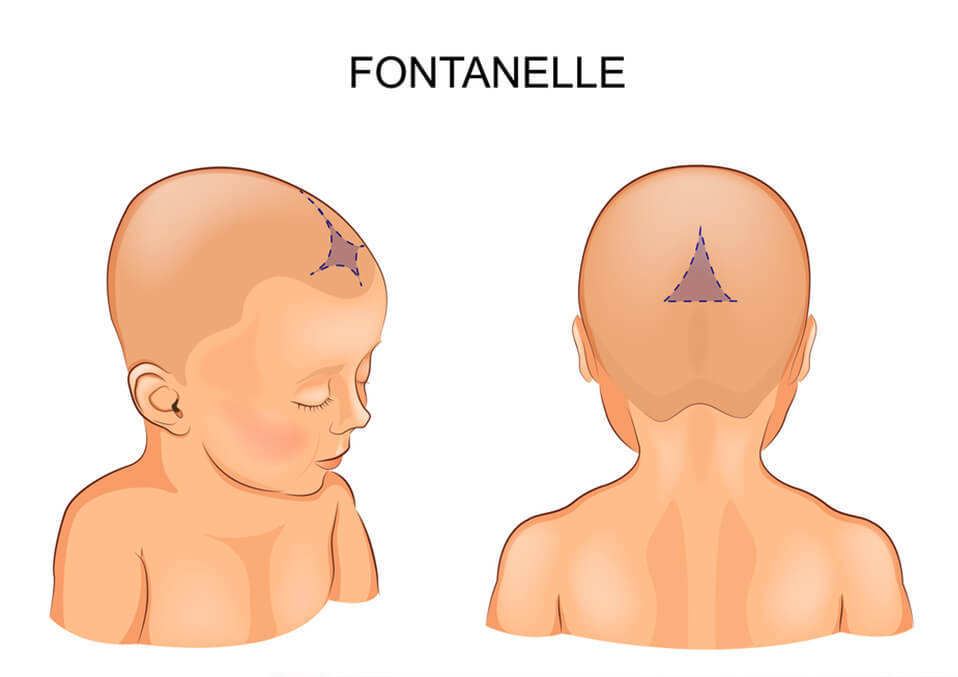
If you are a parent of a newborn or you’re someone who needs to look out for a newborn – whether it’s because of familial duties or for whatever reason you find yourself holding a little human in your arms, you may become extremely cautious. You may be excited about taking care of the infant and at the same dread any potential baby soft spot injury that you may cause because of carelessness. So that you do not have to go into full panic mode, read a few key points to understand that the baby in your arms is tougher than what its soft skin lets on.
A little anatomy

We call it a baby’s soft spot, but in anatomy; it’s called a fontanelle or fontanel – both spellings mean the same thing. In this article; the spelling fontanelle will be used.
Now the reason for this introduction is to emphasize that this soft spot is designed for a reason. And anyone who’s given birth through their birth canal would thank this anatomical feature; as it does help in the delivery – although pushing out a little human that was formed in your womb for months – hurts all the same.
Going back – a baby has fontanelles: an anterior fontanelle (diamond-shaped) and a posterior fontanelle (triangle-shaped); there are two smaller fontanelles found on each side of a baby’s head; but since this is an overview; we’ll just talk about the anterior (front) and the posterior (back).
These fontanelles ossify or hardens – in this case, hardens the muscular tissue into a bony structure – months after the child is born. Specifically; posterior fontanelle ossify within 6 – 8 months, and the anterior fontanelle until 18 months.
Touches and pulses

Holding the infant in your arms and feeling that soft baby skin, you would instinctively think that you’re carrying fragile goods. In a way yes; that little human is much more fragile than a child who is 4 years of age; you may be hesitant to even touch the baby’s soft spot on its head; thinking that you might be poking at its brain; thereby causing baby soft spot injury leading to brain damage. But no; you’re not touching the baby’s brain; although it may feel like it if you’ve dared to touch it before. What you are touching is a protective membrane; which is part of the fontanelle – the anatomical feature that you were introduced to; so the baby can squeeze out of its mother’s birth canal.
How about seeing the pulses in its head, is that normal? Yes. Since fontanelles cover the parts that have not yet fully developed into forming the bony skull that we know of; seeing a pulse is perfectly normal.
That soft spot is strong and telling
Now that we have established that there is a strong fibrous membrane that’s protecting our little human’s brain where the skull hasn’t formed yet; let’s look at potential warning signs.
Here are a few legitimate signs of concern:
- Bulging
- Sunken/ Depressed
- Enlarged
- Third Fontanelle
Bulging: If you see a lump forming at the anterior (front) fontanelle; this could be a sign of increased intracranial pressure.
This can be caused by:
- Encephalitis – brain swelling – commonly by a viral infection.
- Hydrocephalus – Cerebrospinal fluid (CSF) is stockpiling inside the skull.
- Meningitis – membranes (meninges) around the brain are infected.
- Abusive Head Trauma (AHT) or Shaken Baby Syndrome (it may also be known as shaken impact syndrome, and whiplash shake syndrome).
Sunken: also known as depressed fontanelles or what I call capsized fontanelles, which is a sign of dehydration; malnutrition or both.
Enlarged: this is due to slow ossification; but it potentially can never be closed off due to Down syndrome; Hydrocephalus, Intrauterine growth restriction (IUGR) and Premature Birth. There are rare causes as well, but it’s best to check with your doctor to diagnose your child in order to seek prompt medical attention.
Third: sometimes a third fontanelle exists in a newborn – it’s big enough like the anterior [front] and posterior [back] ones. There are serious conditions associated with a third fontanelle so it’s best to have this ruled out by a physician.
The baby keeps getting into trouble
After reading about potential warning signs above, you are likely anxious and now have probably raised your standards of safety for the newborn that you are already guarding with your life. But the baby falls – whether you like it or not – as they slowly learn to stretch and use their limbs, even while in your stronghold. Tossing and turning, they explore and take in much of the world outside of their mother’s womb.
We’ve talked about the fontanelle as an anatomical feature to aid in the birth process, but it also has another function post-birth, and the reason why it doesn’t form into a skull immediately after the baby gets out in the world. It’s their built-in American Football Helmet. No, this doesn’t mean that the baby will be genetically inclined to play sports. But what this does mean is that the baby has a built-in cushion in its head as its center of gravity moves from its head to its hips as they grow up.
So, when they start crawling and bump headfirst into anything in their way, and when they attempt to stand leading to an emergency landing on their bum or most likely their head, that built-in cushion is at work to prevent a serious case of baby soft spot injury.
Read also:
- What Are The White Spots On Baby Face
- Losing Mucus Plug: Is it Something To Worry About?
- Child Care 101: when Can a Baby Use the Bouncer?


